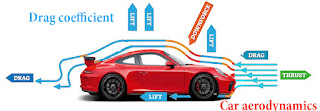The Art of Aerodynamics
Introduction:
In the world of automotive engineering, aerodynamics plays a crucial role in determining the performance, efficiency, and overall driving experience of a vehicle. From sleek supercars to rugged off-roaders, every aspect of a car's design is carefully crafted to minimize drag, maximize downforce, and optimize airflow. In this article, we delve into the fascinating world of car design and aerodynamics, exploring the principles behind it and its impact on vehicle performance.
1. Understanding Aerodynamics:
Aerodynamics is the study of how air flows around objects, such as cars, and how it affects their movement. In the context of automotive engineering, aerodynamics is concerned with reducing drag, which is the resistance encountered by a vehicle as it moves through the air. By minimizing drag, engineers can improve fuel efficiency, increase top speed, and enhance overall performance.
2. Streamlining Design:
One of the primary goals of car design is to create a streamlined shape that allows air to flow smoothly around the vehicle. This typically involves sculpting the bodywork to minimize sharp edges, curves, and protrusions that can disrupt airflow and create turbulence. Smooth, flowing lines and contours help reduce drag and improve aerodynamic efficiency, resulting in better fuel economy and performance.
3. Managing Airflow:
In addition to reducing drag, car designers also focus on managing airflow to optimize performance and stability. This involves directing airflow around and underneath the vehicle to create downforce, which increases traction and stability at high speeds. Features such as spoilers, diffusers, and air dams are strategically placed to manipulate airflow and generate downforce, enhancing cornering grip and overall handling.
4. Balancing Form and Function:
While aerodynamics is critical for performance and efficiency, car designers must also consider aesthetic considerations and brand identity when crafting the exterior appearance of a vehicle. Balancing form and function requires careful attention to detail, as designers strive to create visually appealing shapes that also optimize aerodynamic performance. This delicate balance often involves extensive testing and refinement to achieve the desired combination of style and efficiency.
5. Advancements in Design Technology:
Advancements in computer-aided design (CAD) and computational fluid dynamics (CFD) have revolutionized the way car designers approach aerodynamics. These powerful tools allow engineers to simulate airflow patterns, analyze aerodynamic performance, and optimize vehicle design without the need for costly physical prototypes. By leveraging advanced design technology, automakers can iterate more quickly, refine designs more precisely, and ultimately produce vehicles with superior aerodynamic performance.
6. The Future of Aerodynamic Design:
As automotive technology continues to evolve, the importance of aerodynamics in vehicle design will only grow. With the rise of electric vehicles and autonomous driving systems, aerodynamic efficiency will become even more critical for maximizing range and optimizing energy consumption. Additionally, advances in materials science and manufacturing techniques will enable designers to push the boundaries of aerodynamic performance, creating vehicles that are both efficient and visually stunning.
Conclusion:
Car design and aerodynamics are inextricably linked, with every curve, contour, and surface serving a specific purpose in optimizing airflow and enhancing performance. By understanding the principles of aerodynamics and leveraging advanced design technology, automakers can create vehicles that are not only efficient and aerodynamically optimized but also visually striking and technologically advanced. As we look to the future of automotive engineering, the role of aerodynamics in shaping the cars of tomorrow will continue to be a driving force behind innovation, efficiency, and performance on the road.





Comments
Post a Comment